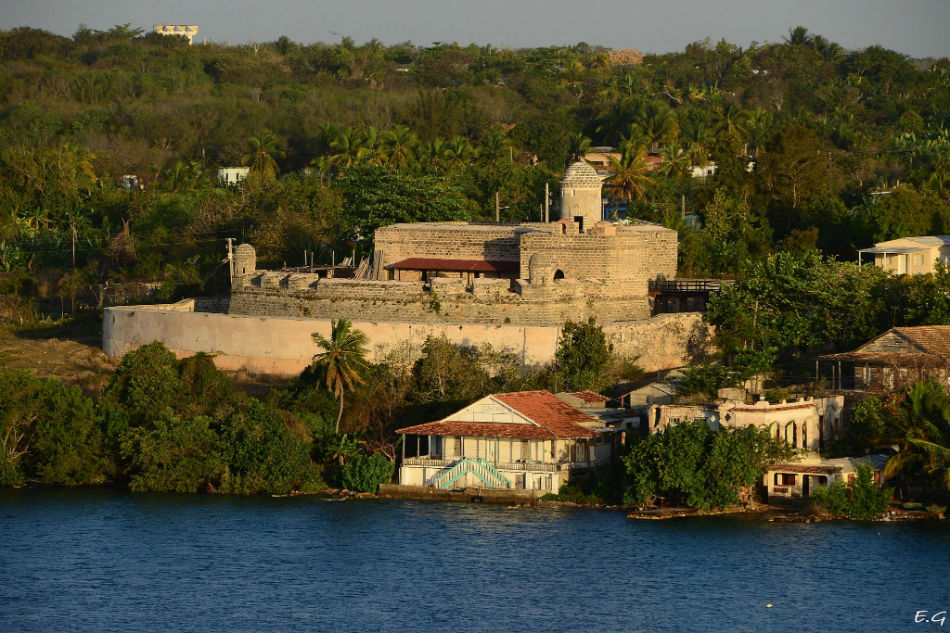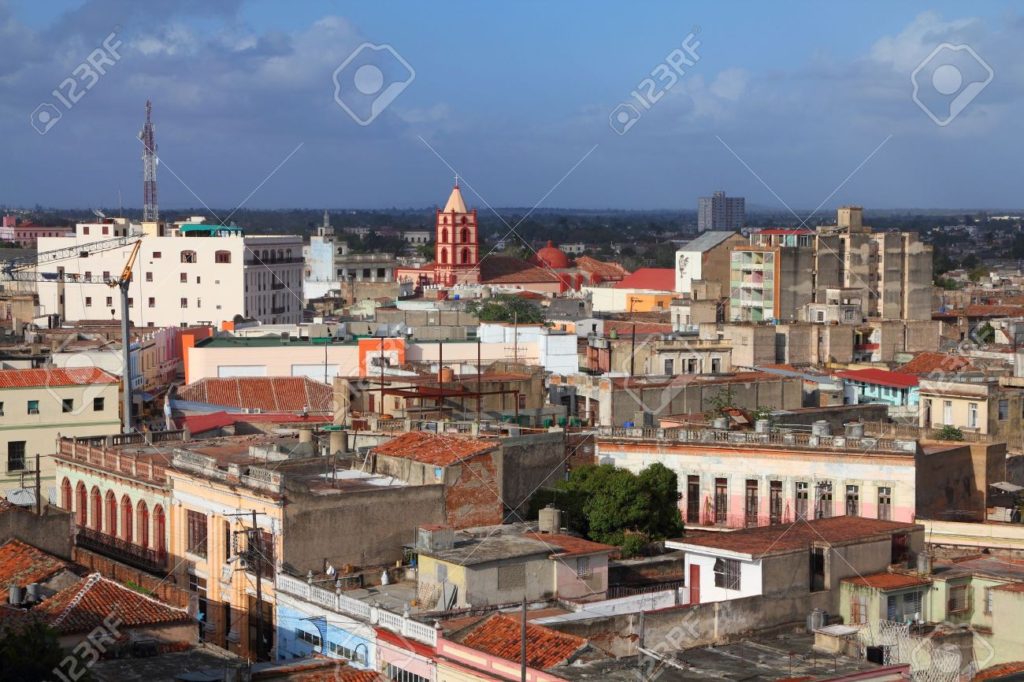Among the powerful walls of the Fortress of Our Lady of the Angels of Jagua, has lived a woman for more than 260 years, trapped by its own history, that men surrounded by myths and legends.
The Blue Lady is named, and in the evenings, during the full moon, the tower, the bell tower, the halls, the chapel and even the castle drawbridge that rises each evening does not let enter the spirits of the filibusters And pirates, and does not let the woman escape.
In those days, the warm waters of the Caribbean Sea were breeding ground for pirates and corsairs, whose vessels pierced them as if it were the palm of their hand. For this reason, the inhabitants of all the islands lived permanently armed. In addition, the extensive and rugged Cuban coasts, the Spanish belligerence against other European powers and the corrupt colonial administration, made of Cuba a focus of attraction for maritime banditry.
The beautiful bay of Jagua was also an ideal place for the so-called rescue or smuggling trade, one of the first creole manifestations of voluntarism before an oppressive, capricious and absorbing administration, so that since 1682, the Royal Company of Commerce of Havana planned To build on the banks of the Bay of Jagua a fortification, which was commissioned to the military engineer Joseph Tantete Dubruller, who completed it completely in 1745.
Built within the canons of Renaissance architecture, it stands out in it its gigantic ashlars of more than one meter wide, extracted from the quarries of Pasacaballo. Its solidity contrasts with the soft beauty of the seascape that can be seen from the bay.
The fort, endowed with guns of diverse caliber and a garrison of soldiers, had like first commander of the fortress to the military of race Don Jose Castile Cabeza de Vaca. He and his wife, Dona Leonor de Cárdenas, inhabited the castle of Jagua until his death, and it is reported that they were buried in the same place.
From then on, during the darkest nights, a huge bird of prey, of strange and frightening appearance, began to fly over the Castle of Jagua whirling in spirals, while it squawked. At her call, the silhouette of a tall, elegant woman, dressed in blue, jeweled and covered with a transparent veil of the same color fluttered in the air, filtered through the walls of the chapel of the castle.
The soldiery assigned to the castle was soon frightened by new events, and many refused to cover night guards. They preferred before, to face the most cruel and criminal pirates that deal with these phantom apparitions.
However, the lieutenant Don Gonzalo, flamboyant and disbelieving, bellowed at the cowardice of his comrades-in-arms and laughed at his supposedly vain fears.
As soon as he could, he placed himself on guard, full of curiosity and emptiness of faith. And there in the open, after the first bell of twelve at night by the great clock of the castle, saw the ghost of the Blue Lady rise from the wall of the chapel. His fellow guards fled while Don Gonzalo prepared himself to face this absurd vision.
At dawn, Don Gonzalo’s colleagues returned to where they had left him last night, surprised by his absence. The young man lay on the floor, under the effects of a fainting that left him unbalanced from his mental faculties. Beside him they found their broken sword in two pieces, a skull and a mysterious blue cloak.
Don Gonzalo spent his remaining days in a hospital for the insane, deprived of his conscience. The Blue Lady of Cienfuegos continued making its night appearances until today. They say that it wanders between the walls of the castle until the first rays of sun appear, then it goes away by the shore as if it walked.
In this regard was consulted the researcher and archaeologist Alfredo Ranking, who explained that in that chapel must appear other bones, because it was also conceived as a place for burials. In addition, he remembered as an unusual fact the finding of a woman’s shoe, as usually only spent military troops since its construction. The female presence was an exception, as was the wife of the first commander of the Fortress, whom some associate with the legend of the Blue Lady, explained the scientist.
Today many think that the apparition is the ghost of Dona Leonor de Cárdenas, and the bird that calls it is the spirit of her husband. There are those who say that the young ensign determined to face her was an old lover or a fervent lover of the beautiful woman who, eager to see her again, found madness and death in that act.
Agencies / Rad.Encyclopedia / Alina Iglesias / Various / Internet Photos / TheCubanHistory.com
THE CUBAN HISTORY, HOLLYWOOD.
FOLLOW US ON TWITTER AND FACEBOOK. THECUBANHISTORY.COM

LEYENDAS CUBANAS: CASTILLO DE JAGUA, CIENFUEGOS Y SU DAMA DE AZUL.
Entre los poderosos muros de la Fortaleza de Nuestra Señora de los Ángeles de Jagua, ha vivido una mujer durante más de 260 años, atrapada por su propia historia, esa que los hombres rodearon de mitos y leyendas.
La nombran La Dama Azul, y por las noches, durante la luna llena recorre aún la torre, el campanario, los salones, la capilla y se llega hasta el puente levadizo del Castillo, que alzado cada atardecer no dejar entrar los espíritus de los filibusteros y piratas, y tampoco deja escapar a la mujer.
En aquellos tiempos, las calientes aguas del mar Caribe eran caldo de cultivo de piratas y corsarios, cuyos bajeles las atravesaban como si se tratara de la palma de su mano. Por esta razón, los habitantes de todas las islas vivían permanentemente armados. Además, lo extenso y accidentado de las costas cubanas, la beligerancia hispana contra otras potencias europeas y la corrupta administración colonial, hicieron de Cuba un foco de atracción para el bandolerismo marítimo.
La preciosa bahía de Jagua fue también lugar ideal para el llamado comercio de rescate o contrabando, una de las primeras manifestaciones criollas de voluntarismo ante una administración opresiva, caprichosa y absorbente, por lo que desde 1682, la Real Compañía de Comercio de La Habana planeó edificar a orillas de la bahía de Jagua una fortificación, que fue encargada al ingeniero militar Joseph Tantete Dubruller, quien la concluyó completamente en 1745.
Realizada dentro de los cánones de la arquitectura renacentista, sobresalen en ella sus gigantescos sillares de más de un metro de ancho, extraídos de las canteras de Pasacaballo. Su solidez contrasta con la suave belleza del paisaje marino que se divisa desde la bahía.
El fuerte, dotado con cañones de diverso calibre y una guarnición de soldados, tuvo como primer comandante de la fortaleza al militar de carrera Don José Castilla Cabeza de Vaca. Él y su esposa, doña Leonor de Cárdenas, habitaron el castillo de Jagua hasta su muerte, y según se cuenta, fueron sepultados en ese mismo lugar.
A partir de entonces, durante las noches más oscuras, un ave enorme de rapiña, de aspecto extraño y aterrador, comenzó a sobrevolar el Castillo de Jagua girando en espirales, mientras graznaba. A su llamado emergía, filtrándose de entre las paredes de la capilla del castillo, la silueta femenina de una mujer alta y elegante, vestida de azul, enjoyada y cubierta con un velo transparente de igual color que ondeaba al aire.
La soldadesca asignada al castillo se atemorizó enseguida por los nuevos sucesos, y muchos se negaban a cubrir las guardias nocturnas. Preferían antes, enfrentar a los más crueles y criminales piratas que lidiar con estas apariciones fantasmagóricas.
Sin embargo, el alférez don Gonzalo, alardoso y descreído, vociferaba burlas sobre la cobardía de sus compañeros de armas y se reía de sus supuestamente vanos temores.
En cuanto pudo, se colocó él mismo de guardia, lleno de curiosidad y vacío de fe. Y allí a la intemperie, tras la primera campanada de las doce de la noche dada por el gran reloj del castillo, vio surgir de la pared de la capilla el fantasma de la Dama Azul. Sus compañeros de guardia huyeron mientras don Gonzalo se aprestó a enfrentar aquella absurda visión.
Al amanecer, retornaron los colegas de don Gonzalo adonde lo habían dejado la noche anterior, extrañados de su ausencia. El joven yacía en el suelo, bajo los efectos de un desmayo que lo dejó desequilibrado de sus facultades mentales. A su lado encontraron su espada partida en dos pedazos, una calavera y un misterioso manto azul.
Don Gonzalo pasó sus restantes días en un hospital para dementes, privado de su conciencia. La Dama Azul de Cienfuegos siguió haciendo sus apariciones nocturnas hasta hoy. Dicen que deambula entre los muros del castillo hasta que asoman los primeros rayos de sol, entonces va alejándose por la orilla como si paseara.
Al respecto fue consultado el investigador y arqueólogo Alfredo Ranking, quien explicó que en esa capilla deben aparecer otras osamentas, porque se concibió también como lugar para los enterramientos. Además, recordó como un hecho insólito el hallazgo de un zapato de mujer, pues por lo general pernoctaron solo tropas militares desde su construcción. La presencia femenina fue una excepción, como lo fue la esposa del primer comandante de la Fortaleza, a quienes algunos vinculan con la leyenda de la Dama Azul, explicó el científico.
Hoy muchos piensan que la aparición es el fantasma de doña Leonor de Cárdenas, y el ave que la llama es el espíritu de su esposo. Hay quien dice también que el joven alférez decidido a enfrentarla, fue un antiguo amante o un ferviente enamorado de la bella mujer, quien, ansioso por volver a verla, encontró la locura y la muerte en aquel acto.
Agencies/Rad.Encyclopedia/Alina Iglesias/Various/Internet Photos/TheCubanHistory.com
THE CUBAN HISTORY, HOLLYWOOD.



 CUBAN LEGENDS: Jagua Castle, Cienfuegos and its Lady in Blue. * LEYENDAS CUBANAS: Castillo de Jagua, Cienfuegos y su Dama de Azul.
CUBAN LEGENDS: Jagua Castle, Cienfuegos and its Lady in Blue. * LEYENDAS CUBANAS: Castillo de Jagua, Cienfuegos y su Dama de Azul.



